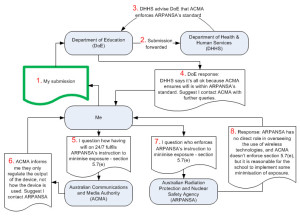In this post I’ll attempt to do what I probably should have done to start with – make a brief précis of why I think parents should be concerned about the astronomical uptake of wireless technologies in education.
Concerns about the standard itself
The baseline
The standard against which wireless devices are currently tested is based on science that determines:
- the point at which the radiation level is such that it causes body tissues to be heated by one degree celcius after half an hour’s exposure.1
- the point at which the radiation level is such that it disrupts food-motivated learned behaviour in laboratory animals2 (that is, the point at which lab animals no longer do the tasks that they have learned will earn them food – the level at which gross behavioural changes are noted, not changes in biochemistry or DNA expression or any other such ‘subtle but sinister’ changes that might occur.)
These effects that the standard is concerned with are referred to as “thermal” effects – the effects purely due to heating. There is no scientific consideration within the standard of what are referred to variously as “non-thermal”, “sub-thermal”, “athermal”, or “biological” effects – that is, any ill-effects caused by the radiation interacting with tissues in ways other than heating. The standards body considers that such non-thermal effects cannot be ruled out, but that there is no scientific consensus or convincing evidence for such effects.
Do biological, non-thermal effects exist?
A brief search in the literature shows that yes, there is certainly evidence to suggest that adverse biological effects are created by non-thermal levels of radiation across a broad spectrum of frequencies – frequencies in which non-thermal effects are not ‘supposed’ to occur, according the standards body. There are certainly scientists who are in no doubt about it. For just one example, consider the study entitled “2.45 GHz radiofrequency fields alter gene expression in cultured human cells”. This study showed that radiation at the frequency of Bluetooth, and very similar to typical wireless, alters one of the most fundamental ‘building’ mechanisms in all life: “data from our study indicate that RF [Radio Frequency] indeed has biological effects”, and that “the altered gene expression in the RF exposed cells was due to non-thermal mechanism(s)”3
Furthermore, in 2010 an international group of concerned life science/health professionals calling themselves the Seletun Scientific Panel, published the Seletun Scientific Statement which, among other things, calls for the current microwave/RF limits to be lowered by 50,000 to 60,000 times.4
Further demonstrating the trend toward growing concern and evidence, in 2011 the World Health Organisation added radio-frequency radiation (which includes wireless) to its list of “possible human carcinogens”.5
The buffer
The actual standard against which wireless devices are currently tested includes a buffer. Anything below the baseline level at which thermal effects are noted is considered safe, but the standard includes a 50-fold buffer for added safety. That is, wireless devices are required to create radiation levels resulting in absorption 50 times lower than the level at which thermal effects have been noted.
While this is a more comforting level, it has already been demonstrated (and acknowledged by the standards body) that the testing methodologies for radiation absorption levels are flawed. The standards body provides a list of radiation levels (called ‘reference levels’) at which radiation absorption limits would not be exceeded. It has been demonstrated that, in children (due to age/body shape/size), these reference levels result in the standard’s maximum radiation absorption levels being exceeded by 40%.6
With regard to the adequacy of the 50-fold buffer, recall that the Seletun Statement recommended lowering the current limit by 50,000 to 60,000 times.
Similary, a paper presented at the 2001 WHO Eastern Regional EMF Meeting and Workshop noted that exposure limits set in China, Russia, and Switzerland were 1000 times lower than those in the US and other countries whose limits were based on the same standard as used in the US (including Australia).7
Is wireless dwarfed by other forms of radiation?
A common argument against concerns for wireless is that, in the mix, wireless accounts for a ridiculously low percentage of the radiation exposures we face on a daily basis anyway. For example, radio and television (which are said to be bombarding us all the time) and mobile phones are often cited as far greater concerns. The absorption due to radiation from a ceiling-mounted wireless router (a common installation technique in schools), for example, is often said to be far less than holding a mobile phone to the head.
This may be true, but more needs to be taken into account than just the power of the devices and the proximity of the router. For example, a study commissioned by the University of Queensland (which was subsequently used by the university to allay concerns) into the wireless radiation levels on that campus actually showed that while the radiation levels on campus were indeed orders of magnitude below the level required by the standard, wireless accounted for 97% of radiation on that campus, against the background levels tested.8
Similarly, even a study funded by the WiFi alliance (a wireless industry body with the stated goal of “driving adoption of high-speed wireless local area networking”) noted that if the antenna of a wireless networking card is placed near the body, the absorbed radiation would be “comparable to that produced by a mobile phone handset”9 – so, if you’re holding a wireless device (like a laptop) or sitting it in your lap, the radiation absorption levels are comparable to that of a mobile phone.
Industry involvement in public health measures
There is a plethora of evidence to suggest that the telecommunications industry carries far too much sway in the ‘scientific’ considerations of public health measures relating to their technologies. Consider, for example, the 280-odd-page PhD thesis written by a gentleman who was actually involved in the standards setting process for RF radiation, subtitled “an examination of the manipulation of telecommunications standards by political, military, and industrial vested interests at the expense of public health protection”.10
An interesting example of how “spin” can create reassurance, is the report of the UK’s Health Protection Agency (HPA), which after extensive study found that “there is no reason why Wi-Fi should not continue to be used in schools”, despite the HPA’s previous chairman having released a report stating that “We conclude therefore that it is not possible at present to say that exposure to RF radiation, even at levels below national guidelines, is totally without potential adverse health effects, and that the gaps in knowledge are sufficient to justify a precautionary approach”. In my submission to the Department of Education, I discussed some of the problems with the HPA’s very forthright, subsequent statement, in light of other research, concluding that:
“In summary, that there is ‘no reason’ wireless networks should not be used in schools, may be true within the apparently very narrow aims of establishing [standards] compliance, but it is far from the full picture. This is a very good example of a case where media coverage of a study could convey very reassuring findings to an unsuspecting public, when in fact all the study has achieved is to demonstrate that devices adhere to standards which are 14 years old, which are demonstrably flawed, which are now being revised, and which could be orders of magnitude too high.”
Simple tests performed by me at a local primary school suggested that wireless networking was “always on” in schools, running 24 hours a day, 7 days a week, institutionally exposing children (who are known to be at higher risk) to a phenomena that the WHO has classed as a possible human carcinogen.
All of the above is discussed in more depth (and, therefore, with more balance) in my submission to the Department of Education (best viewed in a non-browser-based PDF viewer to ensure diagrams are rendered correctly).
References
1: pp. 507, 509 http://www.icnirp.de/documents/emfgdl.pdf
2: “The threshold of 4 W/kg for the disruption of complex behavioral performance in several animal species and under diverse exposure conditions has formed the basis for the setting of human exposure guidelines since 1982.” D’Andrea et al 2003, S58 http://grouper.ieee.org/groups/scc28/sc4/Behavioral%20effects.pdf
3: http://www.ncbi.nlm.nih.gov/pubmed/16107253
4: http://iemfa.org/index.php/publications/seletun-resolution
5: International Agency for Research on Cancer 2011. www.iarc.fr/en/media-centre/pr/2011/pdfs/pr208_E.pdf
6: http://iopscience.iop.org/0031-9155/53/6/001/pdf/pmb8_6_001.pdf
7: http://www.who.int/entity/peh-emf/meetings/en/day2Varna_Foster.pdf
8: http://uqconnect.net/helpdesk/wireless/Wireless-Device-Safety-v5.pdf
9: Foster KR 2007, p 287. http://www.ncbi.nlm.nih.gov/pubmed/17293700
10: http://www.emfacts.com/the-procrustean-approach
Read More


